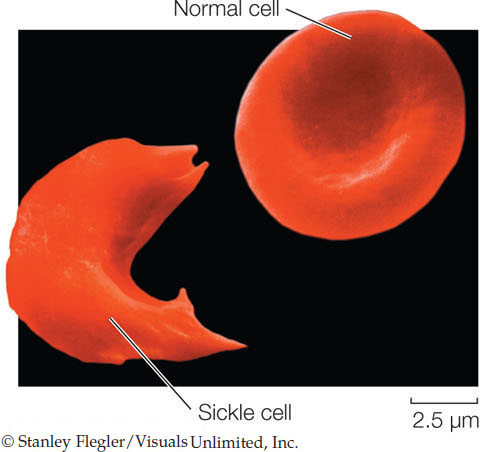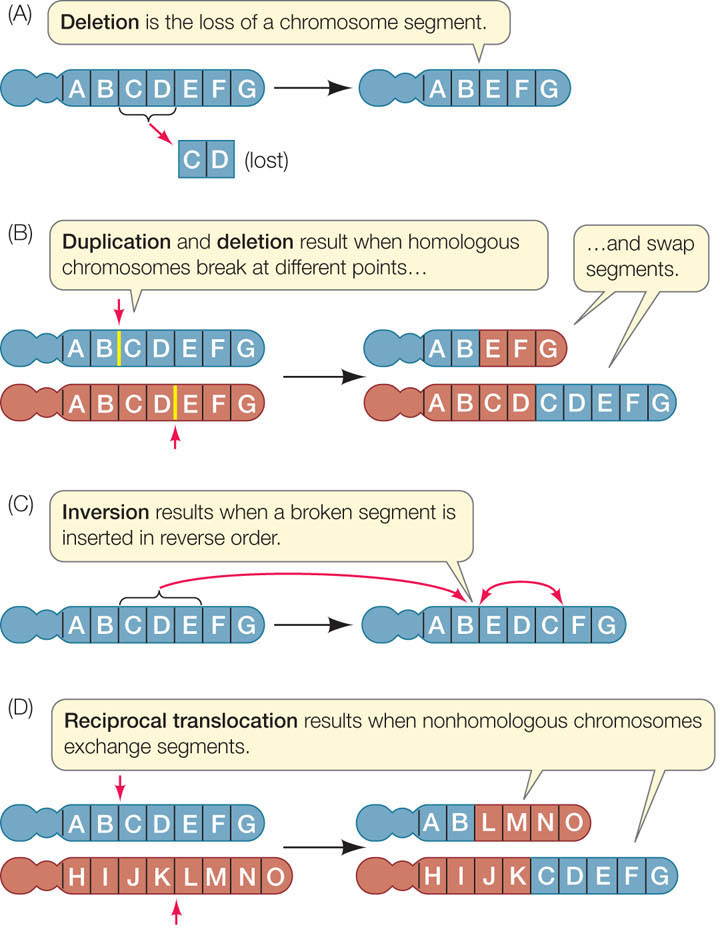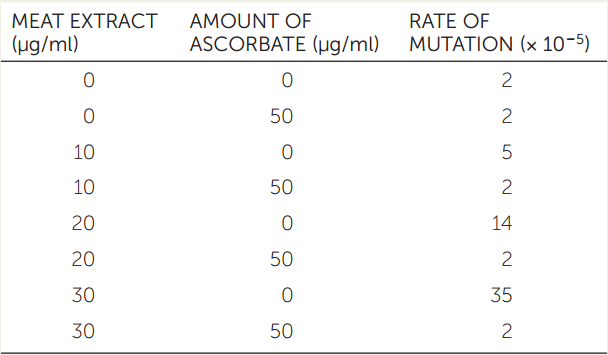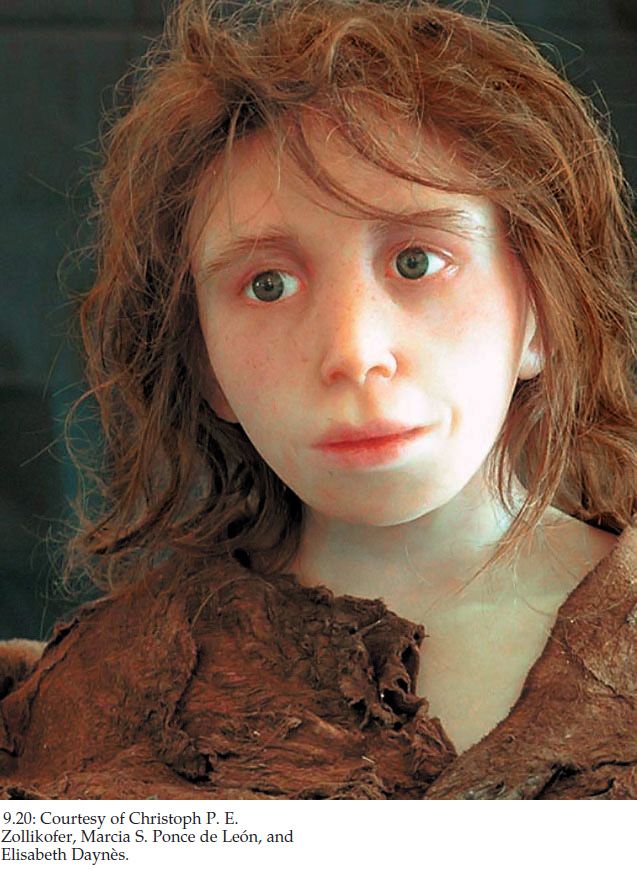CONCEPT9.3 Mutations Are Heritable Changes in DNA
In Chapter 8 we described mutations as stable and inherited changes in the genetic material. A mutation may result in a new allele of a gene, and different alleles may produce different phenotypes (for example, pea plants with wrinkled seeds versus round seeds). With reference to the chemical nature of genes, we can state that mutations are changes in the nucleotide sequence of DNA that are passed on from one cell or organism to another.
Mutations occur by a variety of processes. For example, in Concept 9.2 we described how DNA polymerases can make errors. Repair systems such as proofreading are in place to correct them, but some errors escape being corrected and are passed on to daughter cells.
Mutations in multicellular organisms can be divided into two types:
- Somatic mutations occur in the somatic (body) cells of a multicellular organism. These mutations are passed on to the daughter cells during mitosis, and in turn to the offspring of those cells. For example, a mutation in a single skin cell could result in a patch of skin cells that all have the same mutation. However, somatic mutations are not passed on to sexually produced offspring. (Exceptions occur in plants, where germline cells can arise from somatic cells and thus pass on somatic mutations.)
- Germline mutations occur in the cells of the germ line—the specialized cells that give rise to gametes (the eggs and sperm of sexual reproduction). A gamete with the mutation passes it on to a new organism at fertilization.
In either case, the mutations may or may not affect the phenotype.
187
Mutations can have various phenotypic effects
An organism’s genome is the total DNA sequence present in all of its chromosomes (or in its single chromosome, in the case of prokaryotes). Depending on the organism, it can consist of millions or billions of base pairs of DNA. Most genomes include both genes and regions of DNA that are not expressed.
As we discussed briefly in Concept 3.1, gene expression involves the transcription of DNA into RNA, followed by the translation of the RNA into a polypeptide. (Some RNAs are not translated but have catalytic or other roles in the cell.) We will discuss gene expression in much more detail in Chapter 10. For now we will look at some of the ways that mutations can affect gene expression and phenotypes. It is also the case that many mutations have no effects on phenotypes.
Mutations are often discussed in terms of their effects on protein-coding genes and their functions (FIGURE 9.16):
- Silent mutations do not affect gene function (see Figure 9.16B). They can be mutations in DNA that is not expressed, or mutations within an expressed region that do not have any effect on the encoded protein. Most mutations in large genomes are silent.
LINK
Silent mutations are a source of neutral alleles that can be acted upon by the mechanisms of evolution, as described in Concept 15.2
- Loss-of-function mutations can result in either the loss of expression of a gene or in the production of a nonfunctional protein or RNA. Some loss-of-function mutations prevent a gene from being transcribed or cause transcription to terminate too soon. In other cases the gene is transcribed and translated, but the resulting protein no longer works as a structural protein or enzyme (as illustrated in Figure 9.16C). Loss-of-function mutations almost always show recessive inheritance in a diploid organism, because the presence of one wild-type allele usually results in sufficient functional protein for the cell. For example, the wrinkled seed phenotype studied by Mendel (see Figure 8.1) is due to a recessive loss-of-function mutation in the gene for starch branching enzyme 1 (SBE1). Even in plants with only one copy of the wild-type allele, there is enough SBE1 enzyme to produce the wild-type round phenotype.
- Gain-of-function mutations lead to a protein with an altered function (see Figure 9.16D). This kind of mutation usually shows dominant inheritance, because the presence of the wild-type allele does not prevent the mutant allele from functioning. This type of mutation is common in cancer. For example, a receptor for a growth factor normally requires binding of the growth factor (the ligand) to activate the cell division cycle. Some cancers are caused by mutations in genes that encode these receptors so that the receptors are “always on,” even in the absence of their ligands. This leads to the unrestrained cell proliferation that is characteristic of cancer cells.
- Conditional mutations cause their phenotypes only under certain restrictive conditions. The wild-type phenotype is expressed under other, permissive conditions. Many conditional mutants are temperature-sensitive; that is, they show the altered phenotype only at a certain temperature. For example, in Chapter 8 we described a temperature-sensitive mutation that affects coat color in rabbits and cats. In warmer parts of the body, the mutant protein is inactive, resulting in pale fur. In the cooler extremities of the body, the protein is active, producing dark fur.

All mutations are alterations in the nucleotide sequence of DNA. They can be small-scale mutations that alter only one or a few nucleotides, or they can be large-scale mutations in which entire segments of DNA are rearranged, duplicated, or irretrievably lost. Next we will consider small-scale mutations, in particular, point mutations.
Point mutations are changes in single nucleotides
A point mutation is the addition or subtraction of a single nucleotide base, or the substitution of one base for another. Point mutations can arise because of errors in DNA replication that are not corrected during proofreading, or they may be caused by environmental mutagens: substances that cause mutations, such as radiation or certain chemicals.
188
Some point mutations that occur within genes are loss-of-function mutations because they prevent the gene from being properly transcribed. In other cases the gene is transcribed normally. A point mutation in the coding region of a gene may result in changes in the RNA, but changes in the RNA may or may not result in a change in the amino acid sequence of the protein. If the protein is not changed, the mutation is silent.
Other mutations result in altered amino acid sequences, and in some cases these changes can have drastic phenotypic effects. An example is the mutation that causes sickle-cell disease, a heritable blood disorder. The disease occurs in people who carry two copies of the sickle allele of the gene for human β-globin (a subunit of hemoglobin, the protein in human blood that carries oxygen). The sickle allele differs from the normal allele by one base pair, resulting in a polypeptide that differs by one amino acid from the normal protein. Individuals who are homozygous for this recessive allele have defective, sickle-shaped red blood cells:

The deformed cells tend to block narrow capillaries, which results in tissue damage.
Not all changes in the amino acid sequence of a protein affect its function. For example, a hydrophilic amino acid may be substituted for another hydrophilic amino acid, so that the shape of the protein is unchanged. Or a mutation might result in a protein that has reduced efficiency but is not completely inactivated. Individuals homozygous for a point mutation of this type may show no change in phenotype if enough of the protein’s function is retained.
LINK
Review Concept 3.2 to better understand how a mutation affecting amino acid sequence (the primary protein structure) can affect higher levels of protein structure and thus the protein phenotype
In some cases, gain-of-function point mutations occur. An example is a class of mutations in the human gene TP53, which encodes the tumor suppressor protein p53. The p53 protein normally functions to inhibit the cell cycle, but certain mutations cause the protein to promote the cell cycle and prevent programmed cell death. So a p53 protein mutated in this way has a gain of oncogenic (cancer-causing) function.
Chromosomal mutations are extensive changes in the genetic material
In addition to point mutations there are other kinds of mutations that affect longer sequences of DNA. The most dramatic changes that can occur in the genetic material are chromosomal mutations. Whole chromosomes can break and rejoin, grossly disrupting the sequences of genes. There are four types of chromosomal mutations: deletions, duplications, inversions, and translocations. This kind of severe damage to chromosomes can result from mutagens or from drastic errors in chromosome replication. Like point mutations, chromosome mutations provide new combinations of genes and genetic diversity important to evolution by natural selection.
- Deletions result in the removal of part of the genetic material (FIGURE 9.17A). Their consequences can be severe or even fatal. It is easy to imagine one mechanism that could produce a deletion: a DNA molecule might break at two points and the two end pieces might rejoin, leaving out the DNA between the breaks.
 Figure 9.17: Chromosomal Mutations Chromosomes may break during replication, and parts of chromosomes may then rejoin incorrectly. The letters on these illustrations represent large chromosomal segments containing anywhere from zero to hundreds or thousands of genes.
Figure 9.17: Chromosomal Mutations Chromosomes may break during replication, and parts of chromosomes may then rejoin incorrectly. The letters on these illustrations represent large chromosomal segments containing anywhere from zero to hundreds or thousands of genes. - Duplications can be produced at the same time as deletions (FIGURE 9.17B). A duplication would arise if homologous chromosomes broke at different positions and then reconnected to the wrong partners. One of the two chromosomes produced by this mechanism would lack a segment of DNA (it would have a deletion), and the other would have two copies (a duplication) of the segment that was deleted from the first chromosome.
- Inversions can also result from the breaking and rejoining of chromosomes. A segment of DNA may be removed and reinserted into the same location in the chromosome, but “flipped” end over end so that it runs in the opposite direction (FIGURE 9.17C). If either break site occurs within a gene, it is likely to cause a loss-of-function mutation in that gene.
- Translocations result when segments of chromosomes break off and become joined to different chromosomes. Translocations may involve reciprocal exchanges of chromosome segments, as in FIGURE 9.17D. Translocations often lead to duplications and deletions and may result in sterility if normal chromosome pairing cannot occur during meiosis.
Mutations are heritable changes in DNA
Nitrosamines (R–N–NO2) are potent mutagens. They can be formed from the reaction of nitrites (R–NO2) with amino groups in proteins. So there are concerns about using nitrites to preserve meats, which contain amino groups. An experiment was performed to test the effect of vitamin C (ascorbate) on mutagenesis (induction of mutations) caused by meats cured with nitrites. Bacterial cells were incubated with cured meat extracts in the presence or absence of ascorbate. The rates of mutation (number of mutant bacteria per total bacteria) are shown in the table.
- What did the experiment with no extract and no ascorbate show?
- What did the experiments with increasing amounts of extract and no ascorbate show?
- What was the effect of ascorbate on the mutation rate?

- In the bacterium tested, the wild-type DNA had the sequence 5′-ACTTAT-3′, and the mutated strain had the sequence 5′-ATTTAT-3′. What does this tell you about the nature of the mutation? Outline the steps in mutagenesis, noting DNA replication(s). (Hint: see Figure 9.18.)
LINK
Mobile DNA elements called transposons are another source of mutation; see Figure 12.7
Mutations can be spontaneous or induced
When thinking about the causes of mutations, it is useful to distinguish between mutations that are spontaneous and those that are induced.
Spontaneous mutations are permanent changes in the genetic material that occur without any outside influence. In other words, they occur simply because cellular processes are imperfect. Spontaneous mutations may occur by several mechanisms:
- DNA polymerase can make errors in replication. Most of these errors are repaired by the proofreading function of the replication complex, but some errors escape detection and become permanent.
- The four nucleotide bases of DNA have alternate structures that affect base pairing. Each nucleotide can exist in two different forms (called tautomers), one of which is common and one rare. When a base temporarily forms its rare tautomer, it can pair with the wrong base (FIGURE 9.18A,C).
 Figure 9.18: Spontaneous and Induced Mutations (A) Each of the nitrogenous bases exists in both a common (prevalent) form and a rare form. When a base spontaneously switches to its rare tautomer, it can pair with a different base. (B) Mutagens such as nitrous acid can induce changes in the bases. (C) The results of both spontaneous and induced mutations are permanent changes in the DNA sequence following replication.
Figure 9.18: Spontaneous and Induced Mutations (A) Each of the nitrogenous bases exists in both a common (prevalent) form and a rare form. When a base spontaneously switches to its rare tautomer, it can pair with a different base. (B) Mutagens such as nitrous acid can induce changes in the bases. (C) The results of both spontaneous and induced mutations are permanent changes in the DNA sequence following replication. - Bases in DNA may change because of spontaneous chemical reactions. One such reaction is the deamination (conversion of an amino group to a keto group) in cytosine to form the base uracil, which pairs with A rather than G. Usually these errors are repaired, but since the repair mechanism is not perfect, the altered nucleotide will sometimes remain and cause a permanent base change after replication.
- Meiosis is not perfect. Sometimes errors occur during the complex process of meiosis. This can result in nondisjunction and aneuploidy (see Concept 7.4) or chromosomal breakage and rejoining (discussed above).
- Gene sequences can be disrupted. Random chromosome breakage and rejoining can produce deletions, duplications, inversions, or translocations.
Induced mutations occur when some agent from outside the cell—a mutagen—causes a permanent change in the DNA sequence:
190
- Some chemicals alter the nucleotide bases. For example, nitrous acid (HNO2) reacts with cytosine and converts it to uracil by deamination (FIGURE 9.18B). This alteration has the same result as spontaneous deamination: instead of a G, DNA polymerase inserts an A (see Figure 9.18C).
- Some chemicals add groups to the bases. An example is benzopyrene, a component of cigarette smoke that adds a large chemical group to guanine, making it unavailable for base pairing. When DNA polymerase reaches such a modified guanine, it inserts any one of the four bases, resulting in a high frequency of mutations.

- Radiation damages the genetic material. Radiation can damage DNA in three ways. First, ionizing radiation (including X rays, gamma rays, and particles emitted by unstable isotopes) can detach electrons from atoms or molecules and produce highly reactive chemicals called free radicals. Free radicals can change bases in DNA to forms that are not recognized by DNA polymerase. Second, ionizing radiation can also break the sugar–phosphate backbone of DNA, causing chromosomal abnormalities. And third, ultraviolet radiation (from the sun or a tanning lamp) can cause thymine bases to form covalent bonds with adjacent thymines. This, too, plays havoc with DNA replication by distorting the double helix, and can result in a mutation.
Some base pairs are more vulnerable than others to mutation
DNA sequencing has revealed that mutations occur most often at certain base pairs. These “hotspots” are often located where cytosine has been methylated to 5-methylcytosine. (Methylation of DNA is a normal process in the regulation of chromatin structure and gene expression; see Concept 11.3.)
As we discussed above, unmethylated cytosine can lose its amino group to form uracil (see Figure 9.18B). This error is usually repaired because uracil (which normally occurs in RNA) is recognized by the repair mechanism as an inappropriate component of DNA. When 5-methylcytosine loses its amino group, however, the product is thymine, a natural base in DNA. The DNA repair mechanism ignores the thymine, and in this case, half of the new DNA molecules contain A-T base pairs instead of the original G-C pair (FIGURE 9.19). Thus the frequency of mutation is much greater in regions containing 5-methylcytosine.

191
Mutagens can be natural or artificial
Many people associate mutagens with materials made by humans, but there are also many naturally occurring mutagens. Plants (and to a lesser extent animals) make thousands of small molecules that serve a range of purposes, including defense against pathogens (see Concept 28.1). Some of these are mutagenic and potentially carcinogenic. An example of a naturally occurring mutagen is aflatoxin, which is made by many species of the mold Aspergillus. When mammals ingest the mold, the aflatoxin is converted into a product that binds to guanine and causes mutations, just as benzopyrene from cigarette smoke does.
Radiation can be human-made or natural. Some of the isotopes made in nuclear reactors and nuclear bomb explosions are certainly harmful—as was shown by the increased mutation rates in survivors of the atom bombs dropped on Japan in 1945. A certain amount of radiation comes from space in the form of cosmic radiation, and as mentioned above, natural ultraviolet radiation in sunlight also causes mutations. There is a well-established link between excessive exposure to the sun in light-skinned people and skin cancer.
Biochemists have estimated how much DNA damage occurs in the human genome under normal circumstances: among the haploid genome’s 3.2 billion base pairs, there are about 16,000 DNA-damaging events per cell per day, of which 80 percent are repaired.
Mutations have both benefits and costs
What is the overall effect of mutation? For a species as a whole, the evolutionary benefits are clear. But there are costs as well as benefits for individual organisms.
Benefits Of Mutations
Mutations are the raw material of evolution. As you will see in Part 3 of this book, mutation alone does not drive evolution, but it provides the genetic diversity that makes natural selection possible. A mutation in a germline cell may have no immediate selective advantage to the organism, but it may cause a phenotypic change in the offspring. If the environment changes in a later generation, that mutation may be advantageous, enabling the species as a whole to adapt to changing conditions. A mutation in a somatic cell can sometimes benefit the individual organism, particularly if it occurs in a stem cell that produces a large number of offspring cells.
Costs Of Mutations
Mutations can be harmful if they result in the loss of function of genes (and their protein products) or other DNA sequences that are needed for survival. A harmful mutation in a germline cell may be inherited in heterozygous form by the organism’s descendants. If two individuals carrying the mutation mate, some of the offspring may be homozygous for the mutation. In their extreme form, such mutations produce phenotypes that are lethal. Lethal mutations can kill an organism during early development, or the organism may die before it matures and reproduces.
In Chapter 7 we described how mutations in somatic cells can lead to cancer. Typically these are mutations in oncogenes that result in the stimulation of cell division, or mutations in tumor suppressor genes that result in a lack of inhibition of cell division. These mutations can occur spontaneously or they can be induced.
We attempt to minimize our exposure to mutagens
Spontaneous mutagenesis is not in our control, but we can certainly try to avoid mutagenic substances and radiation. Not surprisingly, many things that cause cancer (carcinogens) are also mutagens. A good example is benzopyrene (discussed above), which is found in coal tar, car exhaust fumes, and char-broiled foods, as well as in cigarette smoke.
A major public policy goal is to minimize the effects of both human-made (anthropogenic) and natural mutagens on human health. For example, the Montreal Protocol (the only international environmental agreement signed and adhered to by all nations) bans chlorofluorocarbons (CFCs) and other substances that deplete the ozone layer in Earth’s upper atmosphere. The ozone layer screens out ultraviolet radiation from the sun—radiation that can cause somatic mutations that lead to skin cancer. Similarly, bans on cigarette smoking have rapidly spread throughout the world. Cigarette smoking causes cancer because of the increased exposure of lung and other cells to benzopyrene and other carcinogens.
192
CHECKpointCONCEPT9.3
- What are the differences between a germline mutation and a somatic mutation?
- Describe how the same base—cytosine—can be mutated spontaneously or by a mutagen. In which case would the mutation be efficiently repaired?
- The Bar eyes mutation in fruit flies was found in genetic crosses to be inherited as an autosomal (non-X chromosome) dominant. Would you expect the mutant allele to be a loss-of-function or a gain-of-function mutation? Explain your answer.
What can we learn from ancient DNA?
ANSWER As we described in the opening story of this chapter, studying the DNA of fossils is a challenge. DNA is a large polymer that is rather stable (Concept 9.1). However, during the formation of fossils, most of the soft tissues and cells are broken down and their contents consumed by organisms in the environment. So it is not surprising that research on ancient DNA has been focused on places where DNA is likely to be preserved intact, such as frozen specimens and the interior of bones.
The polymerase chain reaction (PCR; Concept 9.2) has been invaluable in amplifying tiny amounts of ancient DNA to be sequenced. However, even a single molecule of contaminating DNA can ruin the experiment, because it too will be amplified. This has been a major challenge in studies of ancient DNA related to humans.
The Neandertal Genome Project involves an international team of scientists who are extracting DNA from the bones of skeletons of Neanderthals who lived in Europe more than 50,000 years ago, amplifying it by PCR, and then examining the genes. The entire DNA sequence has been completed. It is more than 99 percent identical to our human DNA, justifying the classification of Neanderthals as part of the same genus, Homo.
Comparisons of humans and Neanderthals with regard to specific genes and mutations (Concept 9.3) is ongoing and has already shown several interesting facts. For example:
- The gene MC1R is involved in skin and hair pigmentation. A point mutation found in Neanderthals but in not humans caused lower activity of the MC1R protein when it was induced in cell cultures. Such lower activity of MC1R is known to result in fair skin and red hair in humans. So it appears that at least some Neanderthals may have had pale skin and red hair (FIGURE 9.20).
 Figure 9.20: A Neanderthal Child This reconstruction of a Neanderthal child who lived about 60,000 years ago was made using bones recovered at Gibraltar, as well as phenotypic projections made from DNA analyses.
Figure 9.20: A Neanderthal Child This reconstruction of a Neanderthal child who lived about 60,000 years ago was made using bones recovered at Gibraltar, as well as phenotypic projections made from DNA analyses. - The gene FOXP2 is involved in vocalization in many organisms, including birds and mammals. Mutations in this gene result in severe speech impairment in humans. The Neanderthal FOXP2 gene is identical to that of humans, whereas that of chimpanzees is slightly different. This has led to speculation that Neanderthals may have been capable of speech.
While the two genome sequences are very similar, there are differences in many point mutations and larger chromosomal arrangements (Concept 9.3). There are distinctive “human” DNA sequences and also distinctive “Neanderthal” sequences. Some Neanderthal sequences have been found in modern humans, indicating that ancient humans and Neanderthals may have interbred. Such reconstructions of ancient DNAs and their phenotypic expression are being repeated for many other species. These studies underline the universality of DNA as the genetic material.
193